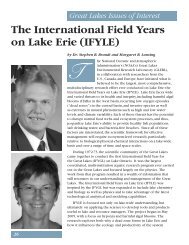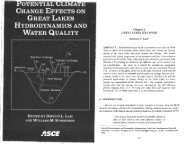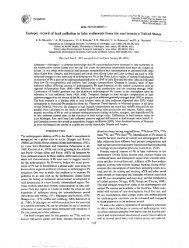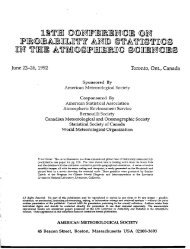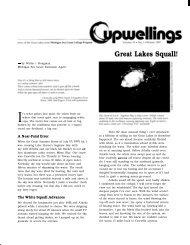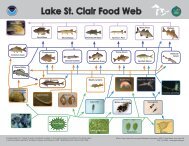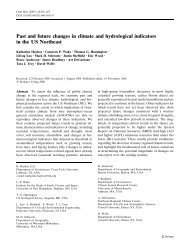Lake Whitefish and Diporeia spp. in the Great ... - GLERL - NOAA
Lake Whitefish and Diporeia spp. in the Great ... - GLERL - NOAA
Lake Whitefish and Diporeia spp. in the Great ... - GLERL - NOAA
Create successful ePaper yourself
Turn your PDF publications into a flip-book with our unique Google optimized e-Paper software.
<strong>Lake</strong> <strong>Whitefish</strong> <strong>and</strong> <strong>Diporeia</strong> <strong>spp</strong>. <strong>in</strong> <strong>the</strong> <strong>Great</strong> <strong>Lake</strong>s:<br />
An Overview<br />
Thomas F. Nalepa 1<br />
<strong>Great</strong> <strong>Lake</strong>s Environmental Research Laboratory<br />
National Oceanic <strong>and</strong> Atmospheric Adm<strong>in</strong>istration<br />
2205 Commonwealth Blvd.<br />
Ann Arbor, Michigan, U.S.A. 48103<br />
Lloyd C. Mohr<br />
Upper <strong>Great</strong> <strong>Lake</strong>s Management Unit, <strong>Lake</strong> Huron, Ontario M<strong>in</strong>istry of<br />
natural Resources<br />
1450 Seventh Avenue East<br />
Owen Sound, Ontario, Canada N4K 2Z1<br />
Bryan A. Henderson<br />
Er<strong>in</strong>dale College<br />
University of Toronto <strong>in</strong> Mississauga<br />
Biology Department<br />
3359 Mississauga Road<br />
North Mississauga, Ontario, Canada L5L 1C6<br />
Charles P. Madenjian<br />
U.S. Geological Survey<br />
<strong>Great</strong> <strong>Lake</strong>s Science Center<br />
1451 Green Road<br />
Ann Arbor, Michigan, U.S.A. 48105<br />
Philip J. Schneeberger<br />
Michigan Department of Natural Resources<br />
Marquette Fisheries Research Station<br />
484 Cherry Creek Road<br />
Marquette, Michigan, U.S.A. 49855<br />
1 Correspond<strong>in</strong>g author: Thomas.Nalepa@noaa.gov<br />
3
Abstract<br />
Because of grow<strong>in</strong>g concern <strong>in</strong> <strong>the</strong> <strong>Great</strong> <strong>Lake</strong>s over<br />
decl<strong>in</strong>es <strong>in</strong> abundance <strong>and</strong> growth of lake whitefish<br />
(Coregonus clupeaformis) <strong>and</strong> decl<strong>in</strong>es <strong>in</strong> abundance of <strong>the</strong><br />
benthic amphipod <strong>Diporeia</strong> <strong>spp</strong>., a workshop was held to<br />
exam<strong>in</strong>e past <strong>and</strong> current trends, to explore trophic l<strong>in</strong>ks,<br />
<strong>and</strong> to discuss <strong>the</strong> latest research results <strong>and</strong> needs. The<br />
workshop was divided <strong>in</strong>to sessions on <strong>the</strong> status of<br />
populations <strong>in</strong> each of <strong>the</strong> lakes, bioenergetics <strong>and</strong> trophic<br />
dynamics, <strong>and</strong> exploitation <strong>and</strong> management. Abundance,<br />
growth, <strong>and</strong> condition of whitefish populations <strong>in</strong> <strong>Lake</strong>s<br />
Superior <strong>and</strong> Erie are stable <strong>and</strong> with<strong>in</strong> <strong>the</strong> range of<br />
historical means, but <strong>the</strong>se variables are decl<strong>in</strong><strong>in</strong>g <strong>in</strong> <strong>Lake</strong>s<br />
Michigan <strong>and</strong> Ontario <strong>and</strong> parts of <strong>Lake</strong> Huron. The loss of<br />
<strong>Diporeia</strong> <strong>spp</strong>., a major food item of whitefish, has been a<br />
factor <strong>in</strong> observed decl<strong>in</strong>es, particularly <strong>in</strong> <strong>Lake</strong> Ontario,<br />
but density-dependent factors also likely played a role <strong>in</strong><br />
<strong>Lake</strong>s Michigan <strong>and</strong> Huron. The loss of <strong>Diporeia</strong> <strong>spp</strong>. is<br />
temporally l<strong>in</strong>ked to <strong>the</strong> <strong>in</strong>troduction <strong>and</strong> proliferation of<br />
dreissenid mussels, but a direct cause for <strong>the</strong> negative<br />
response of <strong>Diporeia</strong> <strong>spp</strong>. has not been established. Given<br />
changes <strong>in</strong> whitefish populations, age-structured models<br />
need to be re-evaluated. O<strong>the</strong>r whitefish research needs to<br />
<strong>in</strong>clude a better underst<strong>and</strong><strong>in</strong>g of what environmental<br />
conditions lead to strong year-classes, improved ag<strong>in</strong>g<br />
techniques, <strong>and</strong> better <strong>in</strong>formation on <strong>in</strong>dividual population<br />
(stock) structure. Fur<strong>the</strong>r collaborations between<br />
assessment biologists <strong>and</strong> researchers study<strong>in</strong>g <strong>the</strong> lower<br />
food web would enhance an underst<strong>and</strong><strong>in</strong>g of l<strong>in</strong>ks between<br />
trophic levels.<br />
4
Introduction<br />
As one of <strong>the</strong> most valued commercial species <strong>in</strong> <strong>the</strong> <strong>Great</strong> <strong>Lake</strong>s, lake<br />
whitefish (Coregonus clupeaformis, hereafter, whitefish) have long been<br />
monitored for changes <strong>in</strong> population status. Timely evaluations of trends <strong>and</strong><br />
an underst<strong>and</strong><strong>in</strong>g of factors that <strong>in</strong>fluence population stability are key<br />
elements <strong>in</strong> effective management of this important species. Over <strong>the</strong> past<br />
century, whitefish populations have fluctuated over a broad scale <strong>in</strong> all <strong>the</strong><br />
lakes except <strong>Lake</strong> Superior. This species comprised a major portion of <strong>the</strong><br />
commercial-fishery harvest <strong>in</strong> <strong>the</strong> <strong>Great</strong> <strong>Lake</strong>s until about <strong>the</strong> 1940s when<br />
<strong>the</strong>ir numbers began to decl<strong>in</strong>e. By <strong>the</strong> 1960s <strong>and</strong> early 1970s, whitefish<br />
populations were at all-time lows. Subsequently, populations began to<br />
recover, <strong>and</strong> above-average harvests were recorded <strong>in</strong> <strong>Lake</strong>s Michigan <strong>and</strong><br />
Huron <strong>in</strong> <strong>the</strong> 1980s <strong>and</strong> 1990s. These wide population fluctuations have<br />
been attributed to various factors, depend<strong>in</strong>g upon <strong>the</strong> particular lake.<br />
Among <strong>the</strong> more significant factors attributed to caus<strong>in</strong>g decl<strong>in</strong>es were<br />
overexploitation, predation by <strong>and</strong> competition with <strong>in</strong>vasive species (i.e.,<br />
sea lamprey (Petromyzon mar<strong>in</strong>us), ra<strong>in</strong>bow smelt (Osmerus mordax), <strong>and</strong><br />
alewife (Alosa pseudoharengus)), <strong>and</strong> degradation of water quality <strong>and</strong><br />
habitat. These negative factors were addressed <strong>in</strong> both specific <strong>and</strong> general<br />
contexts by lake-management agencies, <strong>and</strong> <strong>the</strong> result<strong>in</strong>g recovery of<br />
whitefish populations beg<strong>in</strong>n<strong>in</strong>g <strong>in</strong> <strong>the</strong> 1970s is considered a true success<br />
story (Ebener 1997).<br />
From an ecosystem perspective, coregon<strong>in</strong>es, <strong>in</strong> general, <strong>and</strong> whitefish, <strong>in</strong><br />
particular, are key components of <strong>the</strong> benthic food web of <strong>the</strong> Laurentian<br />
<strong>Great</strong> <strong>Lake</strong>s. <strong>Whitefish</strong> are ma<strong>in</strong>ly benthivores <strong>and</strong> feed preferentially on <strong>the</strong><br />
benthic amphipod <strong>Diporeia</strong> <strong>spp</strong>. (hereafter diporeia as a common name).<br />
<strong>Diporeia</strong> is <strong>the</strong> dom<strong>in</strong>ant component of benthic biomass <strong>and</strong> production <strong>in</strong><br />
<strong>the</strong> colder, offshore regions of <strong>the</strong> <strong>Great</strong> <strong>Lake</strong>s (Cook <strong>and</strong> Johnson 1974).<br />
Both whitefish <strong>and</strong> diporeia are native to <strong>the</strong> <strong>Great</strong> <strong>Lake</strong>s <strong>and</strong> provide an<br />
excellent example of an evolved, efficient trophic pathway that maximizes<br />
energy flow from <strong>the</strong> lower to <strong>the</strong> upper food webs. <strong>Diporeia</strong> lives <strong>in</strong> <strong>the</strong><br />
upper few centimeters of sediment <strong>and</strong> feeds on organic material (mostly<br />
diatoms) freshly settled from <strong>the</strong> water column. Energy fixed as primary<br />
production is thus effectively cycled through diporeia <strong>and</strong> <strong>in</strong>to whitefish<br />
populations, which <strong>the</strong>n serve as a harvested resource.<br />
5
Recent evidence from several of <strong>the</strong> <strong>Great</strong> <strong>Lake</strong>s <strong>in</strong>dicates that populations<br />
of both whitefish <strong>and</strong> diporeia are undergo<strong>in</strong>g drastic changes. For <strong>in</strong>stance,<br />
decreased growth <strong>and</strong> condition of whitefish have been reported <strong>in</strong> regions<br />
of <strong>Lake</strong> Michigan (Pothoven et al. 2001), <strong>and</strong> decreased abundance, growth,<br />
<strong>and</strong> condition have occurred <strong>in</strong> <strong>Lake</strong> Ontario (Hoyle et al. 1999). Similarly,<br />
populations of diporeia have decl<strong>in</strong>ed <strong>in</strong> all <strong>the</strong> lakes except <strong>Lake</strong> Superior,<br />
<strong>and</strong> large areas are now completely devoid of this organism (Dermott <strong>and</strong><br />
Kerec 1997; Nalepa et al. 1998; Lozano et al. 2001). Changes <strong>in</strong> whitefish<br />
<strong>and</strong> diporeia appear to co<strong>in</strong>cide temporally; decreases <strong>in</strong> whitefish growth<br />
<strong>and</strong> condition <strong>in</strong> <strong>Lake</strong>s Michigan <strong>and</strong> Ontario were first observed soon after<br />
<strong>the</strong> loss of diporeia. A work<strong>in</strong>g hypo<strong>the</strong>sis connects decl<strong>in</strong>es <strong>in</strong> whitefish<br />
populations to <strong>the</strong> loss of diporeia as a primary food source. <strong>Diporeia</strong> is rich<br />
<strong>in</strong> lipids <strong>and</strong> high <strong>in</strong> calories. With <strong>the</strong> loss of diporeia, whitefish have been<br />
forced to alter forage patterns <strong>and</strong> feed on benthic organisms that are of<br />
lower nutritional value, are less abundant, or are not as readily available<br />
(Pothoven et al. 2001). Besides <strong>the</strong> loss of diporeia, o<strong>the</strong>r direct or<br />
confound<strong>in</strong>g factors that may also be contribut<strong>in</strong>g to <strong>the</strong> decl<strong>in</strong>e <strong>in</strong> whitefish<br />
growth <strong>and</strong> condition <strong>in</strong>clude density-dependent mechanisms, parasitism,<br />
climate/temperature changes, <strong>and</strong>/or food-web shifts o<strong>the</strong>r than those related<br />
to diporeia. <strong>Diporeia</strong> population decl<strong>in</strong>es co<strong>in</strong>cided with <strong>the</strong> <strong>in</strong>troduction <strong>and</strong><br />
spread of <strong>the</strong> zebra mussel (Dreissena polymorpha) <strong>and</strong> <strong>the</strong> quagga mussel<br />
(D. bugensis). A decrease <strong>in</strong> available food as related to mussel filter<strong>in</strong>g<br />
activities is suspected as a causative factor for <strong>the</strong> observed decl<strong>in</strong>es. This<br />
food-limitation hypo<strong>the</strong>sis, however, is spatially <strong>in</strong>consistent. Decl<strong>in</strong>es occur<br />
<strong>in</strong> lake areas with few or no mussels <strong>and</strong> where food is seem<strong>in</strong>gly still<br />
available (Dermott 2001; Nalepa et al. 2003).<br />
To address <strong>the</strong> many issues related to population trends <strong>in</strong> whitefish <strong>and</strong><br />
diporeia, <strong>the</strong> <strong>Lake</strong> <strong>Whitefish</strong>-<strong>Diporeia</strong> Workshop was held <strong>in</strong> Ann Arbor,<br />
Michigan, <strong>in</strong> February 2002. The primary goals of <strong>the</strong> workshop were to<br />
compare <strong>and</strong> contrast trends <strong>in</strong> each of <strong>the</strong> <strong>Great</strong> <strong>Lake</strong>s so that emerg<strong>in</strong>g<br />
patterns might be better identified, to provide updates on recent research<br />
regard<strong>in</strong>g both organisms, <strong>and</strong> to foster partnerships to address priority<br />
research. The workshop was sponsored by <strong>the</strong> <strong>Great</strong> <strong>Lake</strong>s Fishery<br />
Commission <strong>and</strong> <strong>in</strong>cluded participants from academia; <strong>the</strong> commercial<br />
fishery <strong>in</strong>dustry; <strong>and</strong> federal, prov<strong>in</strong>cial, tribal, <strong>and</strong> state agencies. The<br />
workshop began with a keynote presentation on phenotypic differentiation <strong>in</strong><br />
whitefish populations <strong>in</strong> response to environmental <strong>in</strong>fluences, such as<br />
habitat type <strong>and</strong> prey availability (Bernatchez 2005). Next <strong>in</strong> order were<br />
presentations on population status <strong>in</strong> each of <strong>the</strong> lakes, bioenergetics <strong>and</strong><br />
6
trophic dynamics, <strong>and</strong> exploitation <strong>and</strong> management. Moderated discussions<br />
were held at <strong>the</strong> end of each session, <strong>and</strong> a f<strong>in</strong>al session focused on research,<br />
assessment, <strong>and</strong> management needs. The purpose of this overview is to<br />
summarize highlights of <strong>the</strong> presentations, ensu<strong>in</strong>g discussions, <strong>and</strong> written<br />
proceed<strong>in</strong>gs.<br />
Status of Populations<br />
Historical summaries of trends <strong>in</strong> whitefish populations were presented for<br />
each of <strong>the</strong> <strong>Great</strong> <strong>Lake</strong>s. Although trends prior to recoveries, which began <strong>in</strong><br />
<strong>the</strong> 1960s to <strong>the</strong> 1980s, were generally similar <strong>in</strong> each lake, <strong>the</strong> relative<br />
importance of <strong>in</strong>fluenc<strong>in</strong>g factors <strong>and</strong> <strong>the</strong> role of cumulative effects varied.<br />
For all lakes, <strong>the</strong> most frequently mentioned factors lead<strong>in</strong>g to population<br />
decl<strong>in</strong>es <strong>in</strong> <strong>the</strong> 1950s <strong>and</strong> 1960s were sea lamprey predation <strong>and</strong><br />
overexploitation by <strong>the</strong> fishery. An additional factor (except <strong>in</strong> <strong>Lake</strong><br />
Superior) was predation/competition by <strong>in</strong>troduced planktivores, such as<br />
ra<strong>in</strong>bow smelt <strong>and</strong> alewife. In <strong>Lake</strong> Erie, cultural eutrophication also played<br />
a significant role by caus<strong>in</strong>g oxygen depletion <strong>in</strong> <strong>the</strong> central bas<strong>in</strong>, which<br />
limited whitefish summer habitat (Cook et al. 2005). The tim<strong>in</strong>g of <strong>the</strong><br />
recovery <strong>in</strong> <strong>the</strong> upper lakes <strong>in</strong> <strong>the</strong> 1970s <strong>and</strong> <strong>in</strong> <strong>the</strong> lower lakes <strong>in</strong> <strong>the</strong> 1980s<br />
seems to confirm generalizations regard<strong>in</strong>g specific causes. Control of <strong>the</strong><br />
sea lamprey, better management of <strong>the</strong> commercial fishery, <strong>in</strong>troduction of<br />
salmonids (suppression of exotic planktivores), recovery of walleye<br />
(Stizostedion vitreum), <strong>and</strong> phosphorus abatement were all factors<br />
contribut<strong>in</strong>g to <strong>the</strong> recovery (see <strong>the</strong> <strong>in</strong>dividual papers on <strong>the</strong> status of<br />
whitefish populations <strong>in</strong> this issue).<br />
What are whitefish population trends <strong>in</strong> each of <strong>the</strong> lakes s<strong>in</strong>ce <strong>the</strong> recovery?<br />
In <strong>Lake</strong> Superior, trends <strong>in</strong> catch-per-unit-effort (CPUE) <strong>in</strong> <strong>the</strong> late 1990s<br />
were, notwithst<strong>and</strong><strong>in</strong>g variation among <strong>the</strong> various management zones,<br />
similar to those <strong>in</strong> <strong>the</strong> 1980s (Ebener et al. 2005). Spatial patterns <strong>in</strong> growth<br />
<strong>and</strong> condition were often <strong>in</strong>consistent with expectations of CPUE-derived<br />
abundance estimates, but temporal trends <strong>in</strong> both of <strong>the</strong>se traits <strong>in</strong> <strong>the</strong> 1990s<br />
were consistent with historical values. Population trends <strong>in</strong> <strong>Lake</strong> Erie are<br />
difficult to <strong>in</strong>terpret because of great differences <strong>in</strong> habitat with<strong>in</strong> each of <strong>the</strong><br />
lake’s three bas<strong>in</strong>s <strong>and</strong> <strong>the</strong> movement of fish between bas<strong>in</strong>s (Cook et al.<br />
2005). Most of <strong>the</strong> commercial catch occurs <strong>in</strong> <strong>the</strong> western <strong>and</strong> central<br />
bas<strong>in</strong>s (52% <strong>and</strong> 47%, respectively). Catch rates <strong>in</strong> <strong>the</strong> eastern bas<strong>in</strong> are low<br />
<strong>and</strong> have decl<strong>in</strong>ed recently, but catch rates <strong>in</strong> <strong>the</strong> central bas<strong>in</strong> have<br />
7
<strong>in</strong>creased. For <strong>Lake</strong> Erie as a whole, growth <strong>and</strong> condition have rema<strong>in</strong>ed<br />
stable, <strong>and</strong> current values are with<strong>in</strong> <strong>the</strong> range of historical means. In <strong>Lake</strong><br />
Michigan, despite vary<strong>in</strong>g trends <strong>in</strong> catch <strong>and</strong> effort related to different types<br />
of fish<strong>in</strong>g gear, overall CPUE <strong>in</strong>creased from <strong>the</strong> early 1980s <strong>and</strong> peaked <strong>in</strong><br />
<strong>the</strong> mid-1990s (Schneeberger et al. 2005). Decreases <strong>in</strong> growth <strong>and</strong><br />
condition were noted over <strong>the</strong> same time period. For example, between <strong>the</strong><br />
early <strong>and</strong> late 1990s, length-at-age decl<strong>in</strong>ed by 4-7%, weight-at-age decl<strong>in</strong>ed<br />
by 36-47%, <strong>and</strong> condition decl<strong>in</strong>ed by 34-60%. Decl<strong>in</strong>es <strong>in</strong> growth <strong>and</strong><br />
condition were also observed <strong>in</strong> some regions of <strong>Lake</strong> Huron (Mohr <strong>and</strong><br />
Ebener 2005). In <strong>the</strong> ma<strong>in</strong> bas<strong>in</strong>, North Channel, <strong>and</strong> Georgian Bay, yield<br />
<strong>and</strong> CPUE <strong>in</strong>creased steadily from <strong>the</strong> late 1970s through <strong>the</strong> late 1990s.<br />
S<strong>in</strong>ce <strong>the</strong> early 1980s, decl<strong>in</strong>es <strong>in</strong> growth <strong>and</strong> condition were observed<br />
throughout <strong>the</strong> ma<strong>in</strong> bas<strong>in</strong> but were most pronounced <strong>in</strong> sou<strong>the</strong>rn waters.<br />
Abundance <strong>in</strong> <strong>the</strong> ma<strong>in</strong> bas<strong>in</strong> appears to have peaked <strong>in</strong> <strong>the</strong> mid-1990s <strong>and</strong><br />
has s<strong>in</strong>ce decl<strong>in</strong>ed. In contrast, abundance, growth, <strong>and</strong> condition <strong>in</strong> <strong>the</strong><br />
North Channel <strong>and</strong> Georgian Bay have rema<strong>in</strong>ed stable <strong>in</strong> recent years.<br />
Consider<strong>in</strong>g all <strong>the</strong> lakes, <strong>the</strong> greatest changes have occurred <strong>in</strong> <strong>Lake</strong><br />
Ontario. Commercial harvest <strong>in</strong> this lake <strong>in</strong>creased steadily s<strong>in</strong>ce <strong>the</strong> mid-<br />
1980s, reached a peak <strong>in</strong> <strong>the</strong> mid-1990s, but has s<strong>in</strong>ce decl<strong>in</strong>ed by 66%<br />
(Hoyle 2005). In addition, condition, age-at-maturity, <strong>and</strong> reproductive<br />
success all decl<strong>in</strong>ed after <strong>the</strong> mid-1990s. Most important, <strong>the</strong>se typical<br />
density-dependent attributes cont<strong>in</strong>ued to decrease or rema<strong>in</strong>ed low even as<br />
population abundance decl<strong>in</strong>ed.<br />
The status of whitefish populations <strong>in</strong> two lakes outside <strong>the</strong> <strong>Great</strong> <strong>Lake</strong>s<br />
region (<strong>Lake</strong> Nipigon <strong>and</strong> <strong>Lake</strong> W<strong>in</strong>nipeg) was exam<strong>in</strong>ed to provide a<br />
broader perspective. The commercial harvest <strong>in</strong> <strong>Lake</strong> Nipigon has rema<strong>in</strong>ed<br />
remarkably stable over <strong>the</strong> past 70 years (R. Salmon, Ontario M<strong>in</strong>istry of<br />
Natural Resources, P. O. Box 970, Nipigon, ON P0T 2J0, unpubl.<br />
presentation). Age-at-maturity <strong>and</strong> mean annual harvest (7700 kg; range<br />
2,100 to 10,500 kg per yr) have been consistent over <strong>the</strong> entire period. In<br />
<strong>Lake</strong> W<strong>in</strong>nipeg, whitefish CPUE <strong>and</strong> abundance have been decl<strong>in</strong><strong>in</strong>g s<strong>in</strong>ce<br />
<strong>the</strong> early 1980s (W. Lysack, Manitoba Department of Natural Resources,<br />
Fisheries Branch, 200 Saulteaux Crescent, W<strong>in</strong>nipeg, MB R3J 3W3, unpubl.<br />
presentation). Based on a long-term data set of environmental parameters,<br />
<strong>the</strong>se decl<strong>in</strong>es were probably related to <strong>in</strong>creased eutrophication. Total<br />
carbon <strong>and</strong> chlorophyll <strong>in</strong> <strong>the</strong> water column have <strong>in</strong>creased significantly<br />
s<strong>in</strong>ce <strong>the</strong> early 1980s, <strong>and</strong> recent <strong>in</strong>creases <strong>in</strong> blue-green algal blooms have<br />
been documented. <strong>Diporeia</strong> have also decl<strong>in</strong>ed <strong>in</strong> <strong>Lake</strong> W<strong>in</strong>nipeg. Because<br />
8
dreissenids are not present <strong>in</strong> this lake, <strong>the</strong> decl<strong>in</strong>e is likely related to habitat<br />
deterioration or to predation by an <strong>in</strong>creas<strong>in</strong>g smelt population.<br />
Discussions follow<strong>in</strong>g <strong>the</strong> session on <strong>the</strong> status of populations focused on<br />
two topics: variations <strong>in</strong> growth rates <strong>and</strong> changes <strong>in</strong> spatial distributions.<br />
Because of obvious implications for recruitment, variations <strong>in</strong> whitefish<br />
growth rates among <strong>the</strong> lakes were of <strong>in</strong>terest. Growth rates <strong>in</strong> <strong>Lake</strong>s<br />
Michigan <strong>and</strong> Huron were generally lower after <strong>the</strong> recovery (1980s <strong>and</strong><br />
later) than before populations reached all-time lows (1950s <strong>and</strong> 1960s).<br />
Overfish<strong>in</strong>g <strong>and</strong> <strong>in</strong>tensive sea lamprey predation led to low abundances <strong>and</strong><br />
may have selected slower grow<strong>in</strong>g fish that now comprise populations. In<br />
contrast, whitefish growth rates <strong>in</strong> <strong>Lake</strong> Erie after <strong>the</strong> recovery appear to be<br />
similar to rates prior to <strong>the</strong> period when populations reached all-time lows.<br />
High mortality at early-life stages led to population lows <strong>in</strong> <strong>Lake</strong> Erie <strong>and</strong><br />
was likely associated with eutrophication, which is not thought to cause sizeselective<br />
mortality.<br />
Discussions on recent changes <strong>in</strong> spatial distribution patterns focused on<br />
why whitefish are now found <strong>in</strong> deeper waters dur<strong>in</strong>g summer <strong>in</strong> <strong>Lake</strong>s<br />
Michigan, Huron, <strong>and</strong> Ontario. Hypo<strong>the</strong>ses that account for <strong>the</strong>se changes<br />
<strong>in</strong>clude <strong>in</strong>creased surface-water temperatures associated with climate<br />
warm<strong>in</strong>g, <strong>in</strong>creased light penetration due to dreissenid filter<strong>in</strong>g, <strong>and</strong>/or <strong>the</strong><br />
loss of diporeia. Distributions <strong>in</strong> fall have also changed. In <strong>Lake</strong> Ontario,<br />
whitefish appear to move <strong>in</strong>to shallower water (5-10 m) <strong>and</strong> stay <strong>the</strong>re much<br />
longer than <strong>in</strong> <strong>the</strong> past.<br />
Bioenergetics <strong>and</strong> Trophic Dynamics<br />
The session on bioenergetics <strong>and</strong> trophic dynamics <strong>in</strong>cluded presentations on<br />
<strong>the</strong> status of diporeia populations <strong>in</strong> <strong>the</strong> <strong>Great</strong> <strong>Lake</strong>s, efforts to def<strong>in</strong>e<br />
potential causes for <strong>the</strong>ir decl<strong>in</strong>e, documentation of changes <strong>in</strong> whitefish<br />
diets, <strong>and</strong> implications of <strong>the</strong>se changes for bioenergetics <strong>and</strong> food-web<br />
models. The most recent data on diporeia populations <strong>in</strong> <strong>Lake</strong>s Michigan,<br />
Ontario, <strong>and</strong> Huron show that densities have cont<strong>in</strong>ued to decl<strong>in</strong>e <strong>and</strong> that<br />
<strong>the</strong> areas completely devoid of diporeia are exp<strong>and</strong><strong>in</strong>g (Lozano <strong>and</strong> Scharold<br />
2005; Nalepa et al. 2005). The time from <strong>in</strong>itial decl<strong>in</strong>e to <strong>the</strong> near total loss<br />
of diporeia populations ranged from 6 months to 4-6 years. Although <strong>the</strong><br />
9
diporeia population decl<strong>in</strong>es <strong>in</strong> <strong>the</strong> three lakes co<strong>in</strong>cided with <strong>the</strong><br />
<strong>in</strong>troduction <strong>and</strong> spread of zebra <strong>and</strong>/or quagga mussels, <strong>the</strong> exact cause is<br />
not clear. Peculiarities of amphipod life-history traits <strong>and</strong> population trends,<br />
life-history traits, <strong>and</strong> population trends <strong>in</strong> closely related species (Nalepa et<br />
al. 2005) were exam<strong>in</strong>ed for clues to <strong>the</strong> losses <strong>in</strong> <strong>the</strong> <strong>Great</strong> <strong>Lake</strong>s. Besides<br />
food limitation, o<strong>the</strong>r possible causes were pathogens, oxygen deprivation,<br />
fish predation, <strong>and</strong> contam<strong>in</strong>ants. The role of dreissenids as <strong>the</strong> cause was<br />
exam<strong>in</strong>ed <strong>in</strong> a series of laboratory experiments (Dermott et al. 2005). In<br />
<strong>the</strong>se studies, diporeia mortality was significantly higher <strong>in</strong> sediments from<br />
areas where mussel densities were high <strong>and</strong> diporeia were no longer found<br />
(eastern <strong>Lake</strong> Erie <strong>and</strong> western <strong>Lake</strong> Ontario), as compared to sediments<br />
from an area with no mussels <strong>and</strong> diporeia still present (<strong>Lake</strong> Superior). The<br />
Bay of Qu<strong>in</strong>te, <strong>Lake</strong> Ontario, however, was an anomaly <strong>in</strong> that <strong>the</strong>re was no<br />
mortality <strong>in</strong> sediments from an area where mussels were not present <strong>and</strong><br />
diporeia were no longer found. Biodeposits from dreissenids <strong>in</strong>duced only<br />
slight mortality <strong>in</strong> <strong>the</strong>se studies.<br />
Although <strong>the</strong> exact reason for <strong>the</strong> negative response of diporeia to<br />
dreissenids may never be fully understood, low densities are hav<strong>in</strong>g a major<br />
impact on whitefish feed<strong>in</strong>g. In nearshore areas of <strong>Lake</strong> Michigan where<br />
diporeia are no longer present, whitefish fed mostly on zebra mussels,<br />
gastropods, <strong>and</strong> chironomids, <strong>and</strong> whitefish fed <strong>in</strong> offshore areas on Mysis<br />
relicta (Pothoven 2005). Prior to <strong>the</strong>ir population decl<strong>in</strong>e, diporeia were<br />
clearly <strong>the</strong> preferred food of whitefish—<strong>the</strong> proportion of diporeia <strong>in</strong> <strong>the</strong> diet<br />
<strong>in</strong> various areas of <strong>the</strong> lake was directly related to diporeia abundance <strong>in</strong><br />
those same areas. After <strong>the</strong> loss of diporeia from shallow areas (
Because of changes <strong>in</strong> whitefish feed<strong>in</strong>g <strong>and</strong> <strong>in</strong> spatial distributions, general<br />
bioenergetic models developed for coregon<strong>in</strong>es need to be re-evaluated.<br />
When a coregon<strong>in</strong>e model was applied to size-at-age data for whitefish from<br />
nor<strong>the</strong>rn <strong>Lake</strong> Michigan, it underestimated growth efficiencies when<br />
compared to efficiencies for ano<strong>the</strong>r <strong>Lake</strong> Michigan coregon<strong>in</strong>e—bloater<br />
(Coregonus hoyi)—<strong>and</strong> when compared to efficiencies for whitefish from<br />
<strong>in</strong>l<strong>and</strong> lakes (Madenjian et al. 2005). Insert<strong>in</strong>g a more realistic submodel for<br />
swimm<strong>in</strong>g speed gave more realistic results, but <strong>the</strong> simulation demonstrated<br />
<strong>the</strong> need for a thorough evaluation of coregon<strong>in</strong>e models because of recent<br />
population changes. Three whitefish bioenergetic models (Wiscons<strong>in</strong>, Net<br />
Growth Efficiency, von Bertalanffy Growth) were compared to a<br />
contam<strong>in</strong>ant (mercury) model for fish from Canadian <strong>in</strong>l<strong>and</strong> lakes (M.<br />
Trudel, Department of Fisheries <strong>and</strong> Oceans, Pacific Biological Station,<br />
3190 Hammond Bay Road, Nanaimo, BC V9R 5K6, unpubl. presentation).<br />
Consumption rates relative to growth <strong>and</strong> metabolism varied for each of <strong>the</strong><br />
models, <strong>and</strong> assumptions for each model were discussed.<br />
Because whitefish <strong>and</strong> diporeia are <strong>in</strong>tegral components of <strong>the</strong> food web <strong>in</strong><br />
<strong>Lake</strong> Michigan, <strong>the</strong>ir chang<strong>in</strong>g roles were assessed us<strong>in</strong>g network analysis<br />
(D. Mason, <strong>Great</strong> <strong>Lake</strong>s Environmental Research Laboratory, <strong>NOAA</strong>, 2205<br />
Commonwealth Blvd., Ann Arbor, MI, 48103, unpubl. presentation).<br />
Weighted energy flows through <strong>the</strong> system were constructed for conditions<br />
before <strong>and</strong> after <strong>the</strong> zebra mussel <strong>in</strong>vasion. Prelim<strong>in</strong>ary output suggested<br />
that, although diporeia was once one of <strong>the</strong> most important organisms for<br />
transferr<strong>in</strong>g energy upward <strong>in</strong> <strong>the</strong> food web, it has been replaced <strong>in</strong><br />
importance by dreissenids. More energy is now lost to upper trophic levels<br />
because feed<strong>in</strong>g on dreissenids has higher metabolic costs than feed<strong>in</strong>g on<br />
diporeia. Consequently, <strong>the</strong> capacity of <strong>the</strong> system to support upper trophic<br />
levels has been reduced. Among <strong>the</strong> various fishes exam<strong>in</strong>ed <strong>in</strong> <strong>the</strong> network<br />
analysis, whitefish demonstrated <strong>the</strong> greatest energetic loss when diporeia<br />
populations decl<strong>in</strong>ed, even though o<strong>the</strong>r species such as slimy sculp<strong>in</strong><br />
(Cottus cognatus) were more dependent upon diporeia to meet metabolic<br />
needs prior to <strong>the</strong> decl<strong>in</strong>e. Because diporeia are higher <strong>in</strong> lipids than most<br />
o<strong>the</strong>r potential prey items, <strong>the</strong> ecological consequences of dim<strong>in</strong>ished<br />
numbers of diporeia are greater than simple decl<strong>in</strong>es <strong>in</strong> trophic efficiency<br />
expressed <strong>in</strong> mass. A 53% decl<strong>in</strong>e <strong>in</strong> lipid content of <strong>Lake</strong> Michigan<br />
whitefish occurr<strong>in</strong>g from 1983-1993 to 1996-1999 was attributed to <strong>the</strong> loss<br />
of diporeia (G.M. Wright, Nunns Creek Fishery Enhancement Facility,<br />
Chippewa/Ottawa Resource Authority, Hessel, MI, 49745, unpubl.<br />
11
presentation). Low lipid levels <strong>in</strong> whitefish may depress <strong>the</strong>ir growth,<br />
condition, <strong>and</strong> reproduction.<br />
Discussions follow<strong>in</strong>g <strong>the</strong> bioenergetics <strong>and</strong> trophic-dynamics session<br />
focused on reasons for <strong>the</strong> decl<strong>in</strong>es <strong>in</strong> diporeia <strong>and</strong> on <strong>the</strong> extent that<br />
decl<strong>in</strong>es have led to reductions <strong>in</strong> whitefish growth <strong>and</strong> condition. One<br />
viewpo<strong>in</strong>t (D. Honeyfield, U.S. Geological Survey, Nor<strong>the</strong>rn Appalachian<br />
Research Laboratory, Wellsboro, PA, 16901, pers. commun.) held that<br />
ecological changes result<strong>in</strong>g from <strong>in</strong>vasive species, phosphorus control, <strong>and</strong><br />
contam<strong>in</strong>ants may have led to changes <strong>in</strong> <strong>the</strong> availability of essential<br />
nutrients, <strong>the</strong>reby affect<strong>in</strong>g whitefish <strong>and</strong> diporeia through food-web l<strong>in</strong>ks.<br />
The connection between thiam<strong>in</strong>e deficiency <strong>and</strong> early mortality syndrome<br />
<strong>in</strong> salmonids was offered as an example of <strong>the</strong> effects of nutrient limitation<br />
promulgated through <strong>the</strong> food web. Thiam<strong>in</strong>e deficiency is caused ma<strong>in</strong>ly by<br />
<strong>the</strong> thiam<strong>in</strong>ase carried <strong>in</strong> alewife, o<strong>the</strong>r clupeids, <strong>and</strong> ra<strong>in</strong>bow smelt. When<br />
adult female salmonids feed on alewives, thiam<strong>in</strong>e is catabolized, creat<strong>in</strong>g a<br />
deficiency lead<strong>in</strong>g ultimately to mortality <strong>in</strong> <strong>the</strong>ir progeny. In an analogous<br />
manner, reductions <strong>in</strong> polyunsaturated fatty acids (PUFAs) available to<br />
whitefish from diporeia can be viewed as a nutrient impairment. Because of<br />
<strong>in</strong>creased light penetration result<strong>in</strong>g from dreissenid filter<strong>in</strong>g, phytoplankton<br />
are exposed to higher levels of ultraviolet radiation. Under such conditions,<br />
phytoplankton decrease <strong>the</strong>ir production of PUFAs <strong>and</strong> levels may now be<br />
below critical thresholds for diporeia. Essential nutrients like PUFAs cannot<br />
be manufactured by higher organisms but are essential for <strong>the</strong>ir growth <strong>and</strong><br />
development.<br />
Are decl<strong>in</strong>es <strong>in</strong> growth <strong>and</strong> condition of whitefish a function of high<br />
population density or a result of <strong>the</strong> loss of diporeia? This question has<br />
strong implications for management. If <strong>the</strong> high-density explanation is<br />
correct, it could be argued that exploitation rates can be <strong>in</strong>creased with no<br />
long-term harm to <strong>the</strong> population. Temporal trends <strong>in</strong> <strong>Lake</strong> Ontario,<br />
however, are compell<strong>in</strong>g <strong>and</strong> suggest that decl<strong>in</strong>es <strong>in</strong> whitefish growth <strong>and</strong><br />
condition are a result of <strong>the</strong> loss of diporeia (Hoyle 2005; Owens et al.<br />
2005). In contrast, <strong>in</strong> <strong>Lake</strong> Michigan, <strong>the</strong> loss of diporeia occurred <strong>in</strong> <strong>the</strong><br />
mid-1990s when whitefish populations were at record highs (Schneeberger<br />
et al. 2005). Thus, both high density <strong>and</strong> <strong>the</strong> loss of diporeia may have<br />
contributed to observed decl<strong>in</strong>es <strong>in</strong> whitefish growth <strong>and</strong> condition after <strong>the</strong><br />
mid-1990s. Fur<strong>the</strong>r, <strong>the</strong> condition of several <strong>Lake</strong> Michigan populations<br />
decl<strong>in</strong>ed <strong>in</strong> <strong>the</strong> 1980s, prior to <strong>the</strong> loss of diporeia. <strong>Whitefish</strong> growth <strong>and</strong><br />
12
condition <strong>in</strong> <strong>Lake</strong> Huron appear to be partly density-dependent. Both<br />
parameters began to decl<strong>in</strong>e <strong>in</strong> <strong>the</strong> 1980s, a time prior to <strong>the</strong> <strong>in</strong>vasion of<br />
dreissenids <strong>and</strong> <strong>the</strong> loss of diporeia when abundance was <strong>in</strong>creas<strong>in</strong>g (Mohr<br />
<strong>and</strong> Ebener 2005). Even so, reductions <strong>in</strong> growth <strong>and</strong> condition <strong>in</strong> <strong>the</strong> late<br />
1990s were most severe <strong>in</strong> sou<strong>the</strong>rn waters where diporeia are no longer<br />
present. Based on <strong>the</strong> evidence, decl<strong>in</strong>es <strong>in</strong> whitefish growth <strong>and</strong> condition<br />
<strong>in</strong> both <strong>Lake</strong>s Michigan <strong>and</strong> Huron were most likely, at least <strong>in</strong>itially, a<br />
function of high population densities. The loss of diporeia <strong>in</strong> both lakes is<br />
likely limit<strong>in</strong>g recovery <strong>and</strong> contribut<strong>in</strong>g to fur<strong>the</strong>r decl<strong>in</strong>es.<br />
The decl<strong>in</strong>e of diporeia populations <strong>in</strong> <strong>the</strong> <strong>Great</strong> <strong>Lake</strong>s appears to be<br />
<strong>in</strong>timately associated with <strong>the</strong> <strong>in</strong>troduction <strong>and</strong> proliferation of dreissenids.<br />
Thus, <strong>the</strong> cont<strong>in</strong>ued presence <strong>and</strong> even <strong>in</strong>crease <strong>in</strong> diporeia numbers <strong>in</strong> some<br />
<strong>in</strong>l<strong>and</strong> lakes with dreissenids (e.g. Cayuga <strong>Lake</strong>, New York) is enigmatic<br />
(Dermott et al. 2005). Because <strong>the</strong> extirpation of diporeia can be gradual—<br />
occurr<strong>in</strong>g over a 5- to 6-year period—<strong>in</strong>l<strong>and</strong>-lake populations need to be<br />
monitored for extended time periods.<br />
Exploitation <strong>and</strong> Management<br />
The session on exploitation <strong>and</strong> management exam<strong>in</strong>ed phenotypic<br />
divergence <strong>in</strong> whitefish populations <strong>and</strong> its relevance to management; lifehistory<br />
characteristics of exploited vs. unexploited populations; <strong>and</strong> <strong>the</strong><br />
development, improvement, <strong>and</strong> application of stock-assessment models.<br />
<strong>Whitefish</strong> populations can undergo rapid phenotypic divergence <strong>and</strong><br />
reproductive isolation <strong>in</strong> response to environmental changes (Bernatchez<br />
2005). This process, known as adaptive radiation, is relevant to current foodweb<br />
changes <strong>in</strong> <strong>the</strong> <strong>Great</strong> <strong>Lake</strong>s. With a loss of benthic prey, selection would<br />
favor stocks with higher numbers of gill rakers <strong>and</strong>, thus, a better adaptation<br />
to pelagic feed<strong>in</strong>g. Such populations, however, tend to be smaller bodied for<br />
a given age, younger at maturity, <strong>and</strong> have a shorter life span than<br />
populations found <strong>in</strong> benthic habitat (Bernatchez 2005). New evidence based<br />
on f<strong>in</strong>-ray ag<strong>in</strong>g ra<strong>the</strong>r than scale ag<strong>in</strong>g <strong>in</strong>dicated that unexploited<br />
populations have slower growth, higher annual survival, <strong>and</strong> greater<br />
longevity than previously believed (Mills et al. 2005). Unexploited<br />
populations are, thus, well suited to survive periods of poor recruitment.<br />
13
Comparisons of variations <strong>in</strong> life-history traits (growth, maturity, <strong>and</strong> natural<br />
mortality) of whitefish from <strong>the</strong> <strong>Great</strong> <strong>Lake</strong>s <strong>and</strong> from <strong>in</strong>l<strong>and</strong> lakes showed<br />
that populations with higher growth rates matured at younger ages (K.<br />
Beauchamp, University of Toronto, Biology Department, 3359 Mississauga<br />
Road North, Mississauga, ON L5L 1C6, unpubl. presentation). <strong>Great</strong> <strong>Lake</strong>s<br />
whitefish matured at a younger age, grew faster, <strong>and</strong> achieved larger<br />
asymptotic sizes than <strong>in</strong>l<strong>and</strong>-lake fish, probably due to <strong>the</strong> greater<br />
availability of prey <strong>in</strong> <strong>the</strong> <strong>Great</strong> <strong>Lake</strong>s. An age-structured model based on<br />
Georgian Bay whitefish predicted that maximum susta<strong>in</strong>able yield occurred<br />
at a mortality rate of 0.10 to 0.15 (B. Henderson, University of Toronto,<br />
Biology Department, 3359 Mississauga Road North, Mississauga, ON L5L<br />
1C6, unpubl. presentation). At higher rates, <strong>the</strong> probability of susta<strong>in</strong><strong>in</strong>g a<br />
harvest decl<strong>in</strong>ed dramatically <strong>and</strong> harvest became more variable. Ebener et<br />
al. (2005) summarized <strong>the</strong> development <strong>and</strong> application of catch-at-age<br />
models for whitefish <strong>in</strong> <strong>the</strong> 2000 Consent Decree waters of <strong>Lake</strong>s Superior,<br />
Michigan, <strong>and</strong> Huron. Predicted harvest limits for each management unit<br />
were based on modeled abundance <strong>and</strong> mortality <strong>and</strong> on target mortality<br />
schedules.<br />
Discussion follow<strong>in</strong>g <strong>the</strong> exploitation <strong>and</strong> management session addressed<br />
limitations of age-structured models <strong>and</strong> factors that may affect harvest<br />
predictions. <strong>Whitefish</strong> are managed on a population-by-population basis,<br />
<strong>and</strong>, although some life-history <strong>in</strong>formation for <strong>in</strong>dividual populations is<br />
available, a lack of underst<strong>and</strong><strong>in</strong>g of stock del<strong>in</strong>eation <strong>and</strong> spatial<br />
distribution patterns are major limitations. Fur<strong>the</strong>r, some areas have mixed<br />
stocks where <strong>the</strong> development <strong>and</strong> application of multiple-population<br />
models would improve predictive consistency. Life-history <strong>in</strong>formation has<br />
been useful <strong>in</strong> model development, but multiple-population models are<br />
needed to develop uniform harvest policy. The bias <strong>in</strong> model outputs<br />
result<strong>in</strong>g from <strong>in</strong>accurate ag<strong>in</strong>g methods is also a great concern.<br />
Future Needs: Research, Assessment, Management<br />
If current decl<strong>in</strong>es <strong>in</strong> whitefish abundance, growth, <strong>and</strong> condition are ma<strong>in</strong>ly<br />
a result of food-web disruptions related to <strong>in</strong>vasive species, particularly<br />
dreissenids, <strong>the</strong>n little can be done as long as <strong>the</strong>se <strong>in</strong>vasives rema<strong>in</strong><br />
abundant. Emphasis should be placed on research that enhances current<br />
management strategies. Among <strong>the</strong> most critical needs is a thorough<br />
evaluation of models <strong>and</strong> associated parameters. At <strong>the</strong> very least,<br />
14
parameters need to be prioritized relative to <strong>the</strong> extent <strong>the</strong>y can improve<br />
management decision mak<strong>in</strong>g. One high research priority is an<br />
underst<strong>and</strong><strong>in</strong>g of natural mortality <strong>in</strong> whitefish. In particular, mortality <strong>in</strong> <strong>the</strong><br />
first few years of life has not been adequately measured. In <strong>the</strong> upper <strong>Great</strong><br />
<strong>Lake</strong>s, pre-recruit <strong>in</strong>dices do not accurately predict recruitment.<br />
Environmental conditions that favor survival of young fish need to be<br />
identified along with conditions that favor strong year-classes, which are so<br />
vital to yields. Ag<strong>in</strong>g techniques also need to be improved. Because even<br />
m<strong>in</strong>or mis<strong>in</strong>terpretations of age structure apparently can lead to significant<br />
errors <strong>in</strong> model output, <strong>the</strong> sensitivity of catch-at-age models to ag<strong>in</strong>g errors<br />
needs to be exam<strong>in</strong>ed more thoroughly.<br />
Estimat<strong>in</strong>g reasonable harvest levels is currently limited by <strong>the</strong><br />
unpredictability <strong>and</strong> rapidity by which conditions can change, mak<strong>in</strong>g model<br />
projections <strong>in</strong>accurate. The ra<strong>the</strong>r sudden loss of diporeia <strong>and</strong> its impact on<br />
whitefish growth <strong>and</strong> condition are prime examples. Future models need to<br />
be flexible <strong>and</strong> structured so that new cont<strong>in</strong>gencies can be readily<br />
accommodated.<br />
Life-history attributes <strong>and</strong> environmental requirements of <strong>in</strong>dividual<br />
whitefish populations vary <strong>and</strong> need to be better def<strong>in</strong>ed. Such variability<br />
has long-term implications to management <strong>in</strong> ensur<strong>in</strong>g that overfish<strong>in</strong>g does<br />
not occur. A better def<strong>in</strong>ition of <strong>in</strong>dividual populations would enhance our<br />
underst<strong>and</strong><strong>in</strong>g of risks associated with manag<strong>in</strong>g mixed-stock populations.<br />
Although <strong>the</strong> decl<strong>in</strong>e of diporeia <strong>in</strong> <strong>the</strong> <strong>Great</strong> <strong>Lake</strong>s is well documented,<br />
more effort is needed to def<strong>in</strong>e its cause. If a causative factor can be<br />
identified, <strong>the</strong> risk of fur<strong>the</strong>r decl<strong>in</strong>es can be better assessed, <strong>and</strong> <strong>the</strong><br />
probability of recovery can be determ<strong>in</strong>ed. Exam<strong>in</strong><strong>in</strong>g population trends of<br />
diporeia <strong>and</strong> dreissenids <strong>in</strong> lakes outside <strong>the</strong> <strong>Great</strong> <strong>Lake</strong>s may prove useful.<br />
Prelim<strong>in</strong>ary data suggest that diporeia <strong>and</strong> dreissenids co-exist <strong>in</strong> some<br />
areas. Fur<strong>the</strong>r, know<strong>in</strong>g <strong>the</strong> cause would help def<strong>in</strong>e risks to o<strong>the</strong>r organisms<br />
that serve as alternative food for whitefish, such as Mysis relicta.<br />
F<strong>in</strong>ally, changes <strong>in</strong> populations of whitefish <strong>and</strong> diporeia are likely<br />
symptomatic of broader, more-extensive changes <strong>in</strong> <strong>the</strong> <strong>Great</strong> <strong>Lake</strong>s food<br />
web. Long-term data sets are needed <strong>in</strong> targeted areas to better def<strong>in</strong>e<br />
l<strong>in</strong>kages between lower <strong>and</strong> upper tropic levels. These data can <strong>the</strong>n be used<br />
15
to reassess energy pathways <strong>and</strong> validate new food-web models. Data<br />
collection <strong>and</strong> application can be enhanced by establish<strong>in</strong>g collaborations<br />
between assessment biologists <strong>and</strong> <strong>the</strong> researchers study<strong>in</strong>g lower trophic<br />
levels.<br />
References<br />
Bernatchez, L. 2005. On <strong>the</strong> role of natural selection <strong>in</strong> promot<strong>in</strong>g population<br />
divergence <strong>in</strong> lake whitefish (Coregonus clupeaformis): relevance for<br />
population management <strong>in</strong> <strong>the</strong> <strong>Great</strong> <strong>Lake</strong>s. In Proceed<strong>in</strong>gs of a workshop<br />
on <strong>the</strong> dynamics of lake whitefish (Coregonus clupeaformis) <strong>and</strong> <strong>the</strong><br />
amphipod <strong>Diporeia</strong> <strong>spp</strong>. <strong>in</strong> <strong>the</strong> <strong>Great</strong> <strong>Lake</strong>s. <strong>Great</strong> <strong>Lake</strong>s Fish. Comm.<br />
Tech. Rep. 66 (this issue).<br />
Cook, D.G., <strong>and</strong> Johnson, M.G. 1974. Benthic macro<strong>in</strong>vertebrates of <strong>the</strong> <strong>Great</strong><br />
<strong>Lake</strong>s. J. Fish. Res. Board Can. 31: 763-782.<br />
Cook, A., Johnson, T., Locke, B., <strong>and</strong> Morrison, B. 20054. Status of lake whitefish<br />
(Coregonus clupeaformis) <strong>in</strong> <strong>Lake</strong> Erie. In Proceed<strong>in</strong>gs of a workshop on<br />
<strong>the</strong> dynamics of lake whitefish (Coregonus clupeaformis) <strong>and</strong> <strong>the</strong><br />
amphipod <strong>Diporeia</strong> <strong>spp</strong>. <strong>in</strong> <strong>the</strong> <strong>Great</strong> <strong>Lake</strong>s. <strong>Great</strong> <strong>Lake</strong>s Fish. Comm.<br />
Tech. Rep. 66 (this issue).<br />
Dermott, R. 2001. Sudden disappearance of <strong>the</strong> amphipod <strong>Diporeia</strong> from eastern<br />
<strong>Lake</strong> Ontario, 1993-1995. J. <strong>Great</strong> <strong>Lake</strong>s Res. 27: 423-433.<br />
Dermott, R., <strong>and</strong> Kerec, D. 1997. Changes <strong>in</strong> <strong>the</strong> deepwater benthos of eastern <strong>Lake</strong><br />
Erie s<strong>in</strong>ce <strong>the</strong> <strong>in</strong>vasion of Dreissena: 1973-1993. Can. J. Fish. Aquat. Sci.<br />
54: 922-930.<br />
Dermott, R., Munawar, M., Bonnell, R., Carou, S., Niblock, H., Nalepa, T.F., <strong>and</strong><br />
Messick, G. 2005. Prelim<strong>in</strong>ary <strong>in</strong>vestigations for causes of <strong>the</strong><br />
disappearance of <strong>Diporeia</strong> <strong>spp</strong>. from <strong>Lake</strong> Ontario. In Proceed<strong>in</strong>gs of a<br />
workshop on <strong>the</strong> dynamics of lake whitefish (Coregonus clupeaformis) <strong>and</strong><br />
<strong>the</strong> amphipod <strong>Diporeia</strong> <strong>spp</strong>. <strong>in</strong> <strong>the</strong> <strong>Great</strong> <strong>Lake</strong>s. <strong>Great</strong> <strong>Lake</strong>s Fish. Comm.<br />
Tech. Rep. 66 (this issue).<br />
Ebener, M.P. 1997. Recovery of lake whitefish populations <strong>in</strong> <strong>the</strong> <strong>Great</strong> <strong>Lake</strong>s: a<br />
story of successful management <strong>and</strong> just pla<strong>in</strong> luck. Fisheries 22: 18-20.<br />
16
Ebener, M.P. 2005. Status of lake whitefish (Coregonus clupeaformis) populations<br />
<strong>in</strong> <strong>Lake</strong> Huron. In Proceed<strong>in</strong>gs of a workshop on <strong>the</strong> dynamics of lake<br />
whitefish (Coregonus clupeaformis) <strong>and</strong> <strong>the</strong> amphipod <strong>Diporeia</strong> <strong>spp</strong>. <strong>in</strong> <strong>the</strong><br />
<strong>Great</strong> <strong>Lake</strong>s. <strong>Great</strong> <strong>Lake</strong>s Fish. Comm. Tech. Rep. 66 (this issue).<br />
Ebener, M.P., Bence, J.R., Newman, K., <strong>and</strong> Schneeberger, P.J. 2005. Application of<br />
statistical catch-at-age models to assess lake whitefish stocks <strong>in</strong> <strong>the</strong> 1836<br />
treaty-ceded waters of <strong>the</strong> upper <strong>Great</strong> <strong>Lake</strong>s. In Proceed<strong>in</strong>gs of a<br />
workshop on <strong>the</strong> dynamics of lake whitefish (Coregonus clupeaformis) <strong>and</strong><br />
<strong>the</strong> amphipod <strong>Diporeia</strong> <strong>spp</strong>. <strong>in</strong> <strong>the</strong> <strong>Great</strong> <strong>Lake</strong>s. <strong>Great</strong> <strong>Lake</strong>s Fish. Comm.<br />
Tech. Rep. 66 (this issue).<br />
Hoyle, J.A., Schaner, T., Casselman, J.M., <strong>and</strong> Dermott, R. 1999. Changes <strong>in</strong> lake<br />
whitefish (Coregonus clupeaformis) stocks <strong>in</strong> eastern <strong>Lake</strong> Ontario<br />
follow<strong>in</strong>g Dreissena mussel <strong>in</strong>vasion. <strong>Great</strong> <strong>Lake</strong>s Res. Rev. 4: 5-10.<br />
Hoyle, J.A. 2005. Status of lake whitefish (Coregonus clupeaformis) <strong>in</strong> <strong>Lake</strong> Ontario<br />
<strong>and</strong> <strong>the</strong> response to <strong>the</strong> disappearance of <strong>Diporeia</strong> <strong>spp</strong>. In Proceed<strong>in</strong>gs of a<br />
workshop on <strong>the</strong> dynamics of lake whitefish (Coregonus clupeaformis) <strong>and</strong><br />
<strong>the</strong> amphipod <strong>Diporeia</strong> <strong>spp</strong>. <strong>in</strong> <strong>the</strong> <strong>Great</strong> <strong>Lake</strong>s. <strong>Great</strong> <strong>Lake</strong>s Fish. Comm.<br />
Tech. Rep. 66 (this issue).<br />
Lozano, S.J., Scharold, J.V., Nalepa, T.F. 2001. Recent decl<strong>in</strong>es <strong>in</strong> benthic<br />
macro<strong>in</strong>vertebrate densities <strong>in</strong> <strong>Lake</strong> Ontario. Can. J. Fish. Aquat. Sci. 58:<br />
518-529.<br />
Lozano, S.J. <strong>and</strong> Scharold, J.V. 2005. The status of <strong>Diporeia</strong> <strong>spp</strong>. <strong>in</strong> <strong>Lake</strong> Ontario,<br />
1994-1997. In Proceed<strong>in</strong>gs of a workshop on <strong>the</strong> dynamics of lake<br />
whitefish (Coregonus clupeaformis) <strong>and</strong> <strong>the</strong> amphipod <strong>Diporeia</strong> <strong>spp</strong>. <strong>in</strong> <strong>the</strong><br />
<strong>Great</strong> <strong>Lake</strong>s. <strong>Great</strong> <strong>Lake</strong>s Fish. Comm. Tech. Rep. 66 (this issue).<br />
Madenjian, C.P., Pothoven, S.A., Schneeberger, P.J., O’Connor, D.V., <strong>and</strong> Br<strong>and</strong>t,<br />
S.B. 2005. Prelim<strong>in</strong>ary evaluation of a lake whitefish (Coregonus<br />
clupeaformis) bioenergetics model. In Proceed<strong>in</strong>gs of a workshop on <strong>the</strong><br />
dynamics of lake whitefish (Coregonus clupeaformis) <strong>and</strong> <strong>the</strong> amphipod<br />
<strong>Diporeia</strong> <strong>spp</strong>. <strong>in</strong> <strong>the</strong> <strong>Great</strong> <strong>Lake</strong>s. <strong>Great</strong> <strong>Lake</strong>s Fish. Comm. Tech. Rep. 66<br />
(this issue).<br />
17
Mills, K.H., Gyselman, E.C., Chalanchuk, S.M., <strong>and</strong> Allan, D.J. 2005. The<br />
population dynamics of unexploited lake whitefish (Coregonus<br />
clupeaformis) populations <strong>and</strong> <strong>the</strong>ir responses to stresses. In Proceed<strong>in</strong>gs of<br />
a workshop on <strong>the</strong> dynamics of lake whitefish (Coregonus clupeaformis)<br />
<strong>and</strong> <strong>the</strong> amphipod <strong>Diporeia</strong> <strong>spp</strong>. <strong>in</strong> <strong>the</strong> <strong>Great</strong> <strong>Lake</strong>s. <strong>Great</strong> <strong>Lake</strong>s Fish.<br />
Comm. Tech. Rep. 66 (this issue).<br />
Mohr, L.C. <strong>and</strong> Ebener, M.P. 2005. Status of lake whitefish (Coregonus<br />
clupeaformis) <strong>in</strong> <strong>Lake</strong> Huron. In Proceed<strong>in</strong>gs of a workshop on <strong>the</strong><br />
dynamics of lake whitefish (Coregonus clupeaformis) <strong>and</strong> <strong>the</strong> amphipod<br />
<strong>Diporeia</strong> <strong>spp</strong>. <strong>in</strong> <strong>the</strong> <strong>Great</strong> <strong>Lake</strong>s. <strong>Great</strong> <strong>Lake</strong>s Fish. Comm. Tech. Rep. 66<br />
(this issue).<br />
Nalepa, T.F., Hartson, D.J., Fanslow, D.L., Lang, G.A., <strong>and</strong> Lozano, S.J. 1998.<br />
Decl<strong>in</strong>e of benthic macro<strong>in</strong>vertebrate populations <strong>in</strong> sou<strong>the</strong>rn <strong>Lake</strong><br />
Michigan, 1980-1993. Can. J. Fish. Aquat. Sci. 55: 2402-2413.<br />
Nalepa, T.F., Fanslow, D.L., Lans<strong>in</strong>g, M.L., <strong>and</strong> Lang, G.A. 2003. Trends <strong>in</strong> <strong>the</strong><br />
benthic macro<strong>in</strong>vertebrate community <strong>in</strong> Sag<strong>in</strong>aw Bay, <strong>Lake</strong> Huron, 1987<br />
to 1996: responses to phosphorus abatement <strong>and</strong> <strong>the</strong> zebra mussel,<br />
Dreissena polymorpha. J. <strong>Great</strong> <strong>Lake</strong>s Res. 29: 14-33.<br />
Nalepa, T.F., Fanslow, D.L., <strong>and</strong> Messick, G.A. 2005. Characteristics <strong>and</strong> potential<br />
causes of decl<strong>in</strong><strong>in</strong>g <strong>Diporeia</strong> <strong>spp</strong>. populations <strong>in</strong> sou<strong>the</strong>rn <strong>Lake</strong> Michigan<br />
<strong>and</strong> Sag<strong>in</strong>aw Bay, <strong>Lake</strong> Huron. In Proceed<strong>in</strong>gs of a workshop on <strong>the</strong><br />
dynamics of lake whitefish (Coregonus clupeaformis) <strong>and</strong> <strong>the</strong> amphipod<br />
<strong>Diporeia</strong> <strong>spp</strong>. <strong>in</strong> <strong>the</strong> <strong>Great</strong> <strong>Lake</strong>s. <strong>Great</strong> <strong>Lake</strong>s Fish. Comm. Tech. Rep. 66<br />
(this issue).<br />
Owens, R.W., O’Gorman, R., Eckert, T.H., Lantry, B., <strong>and</strong> Dittman, D.E. 2005.<br />
Recovery <strong>and</strong> decl<strong>in</strong>e of lake whitefish <strong>in</strong> U.S. waters of eastern <strong>Lake</strong><br />
Ontario, 1980-2001. In Proceed<strong>in</strong>gs of a workshop on <strong>the</strong> dynamics of lake<br />
whitefish (Coregonus clupeaformis) <strong>and</strong> <strong>the</strong> amphipod <strong>Diporeia</strong> <strong>spp</strong>. <strong>in</strong> <strong>the</strong><br />
<strong>Great</strong> <strong>Lake</strong>s. <strong>Great</strong> <strong>Lake</strong>s Fish. Comm. Tech. Rep. 66 (this issue).<br />
Pothoven, S.A., Nalepa, T.F., Schneeberger, P.J., <strong>and</strong> Br<strong>and</strong>t, S.B. 2001. Changes <strong>in</strong><br />
diet <strong>and</strong> body condition of lake whitefish <strong>in</strong> sou<strong>the</strong>rn <strong>Lake</strong> Michigan<br />
associated with changes <strong>in</strong> benthos. North Am. J. Fish. Manag. 21: 876-<br />
883.<br />
18
Pothoven, S.A. 2005. Changes <strong>in</strong> lake whitefish diet <strong>in</strong> <strong>Lake</strong> Michigan. In<br />
Proceed<strong>in</strong>gs of a workshop on <strong>the</strong> dynamics of lake whitefish (Coregonus<br />
clupeaformis) <strong>and</strong> <strong>the</strong> amphipod <strong>Diporeia</strong> <strong>spp</strong>. <strong>in</strong> <strong>the</strong> <strong>Great</strong> <strong>Lake</strong>s. <strong>Great</strong><br />
<strong>Lake</strong>s Fish. Comm. Tech. Rep. 66 (this issue).<br />
Schneeberger, P.J., Ebener, M., Toneys, M., <strong>and</strong> Peeters, P. 2005. Status of lake<br />
whitefish (Coregonus clupeaformis) <strong>in</strong> <strong>Lake</strong> Michigan. In Proceed<strong>in</strong>gs of a<br />
workshop on <strong>the</strong> dynamics of lake whitefish (Coregonus clupeaformis) <strong>and</strong><br />
<strong>the</strong> amphipod <strong>Diporeia</strong> <strong>spp</strong>. <strong>in</strong> <strong>the</strong> <strong>Great</strong> <strong>Lake</strong>s. <strong>Great</strong> <strong>Lake</strong>s Fish. Comm.<br />
Tech. Rep. 66 (this issue).<br />
19




